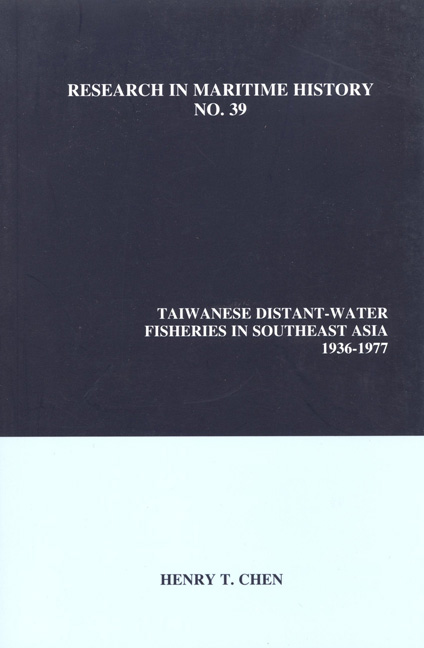Book contents
- Frontmatter
- Contents
- List of Tables
- List of Illustrations
- Notes on the Sources
- About the Author
- Acknowledgements
- Introduction
- Chapter 1 Japan and the Development of Taiwan's Fishing Industry
- Chapter 2 The Revival of the Fishing Industry in Postwar Taiwan
- Chapter 3 Kaohsiung Fishing Port and Its Fishing Ancillary Industries
- Chapter 4 The Taiwanese Fishing Industry and the Military-Political Complex
- Chapter 5 The Kaohsiung Fishing Industry and Its Ancillary Industries
- Chapter 6 The Development of Kaohsiung's Fishing Companies
- Chapter 7 Daily Lives at Sea, Fishing Zones and Politics
- Chapter 8 The Culture and Daily Life of the Kaohsiung Fishing Communities
- Chapter 9 The 1970s Crisis in the Taiwanese Fishing Industry
- Conclusion
- Appendix 1 List of Informants
- Select Bibliography
Chapter 3 - Kaohsiung Fishing Port and Its Fishing Ancillary Industries
- Frontmatter
- Contents
- List of Tables
- List of Illustrations
- Notes on the Sources
- About the Author
- Acknowledgements
- Introduction
- Chapter 1 Japan and the Development of Taiwan's Fishing Industry
- Chapter 2 The Revival of the Fishing Industry in Postwar Taiwan
- Chapter 3 Kaohsiung Fishing Port and Its Fishing Ancillary Industries
- Chapter 4 The Taiwanese Fishing Industry and the Military-Political Complex
- Chapter 5 The Kaohsiung Fishing Industry and Its Ancillary Industries
- Chapter 6 The Development of Kaohsiung's Fishing Companies
- Chapter 7 Daily Lives at Sea, Fishing Zones and Politics
- Chapter 8 The Culture and Daily Life of the Kaohsiung Fishing Communities
- Chapter 9 The 1970s Crisis in the Taiwanese Fishing Industry
- Conclusion
- Appendix 1 List of Informants
- Select Bibliography
Summary
The rapid growth of Taiwan's postwar fisheries resulted largely from rational national policies and international financial assistance. Nonetheless, there were also some local conditions that fostered its development, especially in Kaohsiung, although little attention has thus far been paid to them. Kaohsiung Fishing Port experienced dramatic changes over the course of the twentieth century. During the colonial era, it was simply a strategic forward base for Japan's southward-oriented fishing industry. But after World War II, it was gradually transformed into one of the most important regional centres for the new global fisheries. During this process, there was an urgent need for a modern shipbuilding industry in Kaohsiung. There was also a need for an efficient icemanufacturing industry to cater to the fresh-fish trade.
The purpose of this chapter is to describe the construction of Kaohsiung Fishing Port, the development of its ancillary industries and how they contributed to the postwar revival of Taiwan's fisheries. I will begin by describing the building of Kaohsiung Fishing Port and its management. I will then focus on the ancillary industries, such as shipbuilding, ice manufacturing and fish processing, and assess their contribution to Kaohsiung's fishing industry. Finally, I will address southern Taiwan's fisheries education programme, considering especially how it supported fisheries development.
Reconstruction of Kaohsiung Fishing Port
During World War II, Takao Fishing Port was destroyed by American bombers. Most of its infrastructure was devastated; many vessels were sunk; and the waterways, channels and docks were obstructed by debris. This made the reconstruction and revitalization of the port a top priority for Taiwan's fisheries authorities.
The postwar reconstruction of Kaohsiung Fishing Port resulted in tremendous changes in both its size and nature. Before 1945, the Takao (Kaohsiung) Fishing Port referred specifically to the Shösento Fishing Harbour [Shaochuantou], located in what is now called Gushan District. But in the postwar years Kaohsiung Fishing Port was greatly enlarged and renovated. In addition to rebuilding Gushan Fishing Port, a modern, distant-water fishing port built in 1967 in Cianjhen District attracted a large number of distant-water vessels originally based in Gushan. Several offshore harbours were also built in the Cijin District which encouraged a growing number of fishers to leave the coastal areas and fish off Southeast Asia. All these ports and harbours were generally considered to be part of Kaohsiung Fishing Port (see figure 3.1).
- Type
- Chapter
- Information
- Publisher: Liverpool University PressPrint publication year: 2009



